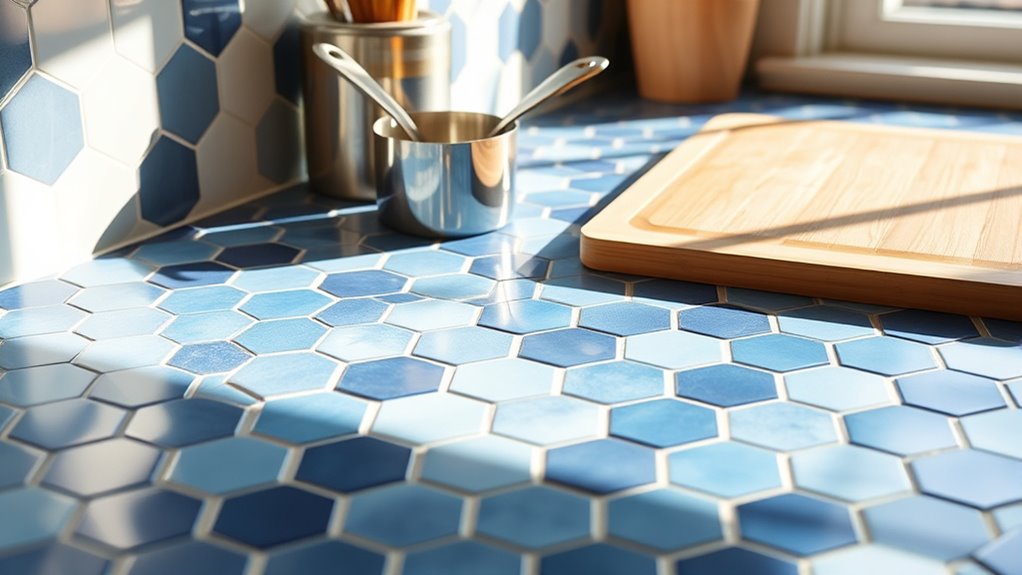You use geometry every day in simple tasks like arranging furniture, cutting paper, or fixing things around your home, often without realizing it. You’re measuring angles when opening doors, aligning picture frames, or hanging curtains. Recognizing patterns helps in cooking, organizing spaces, or choosing designs. Principles of shapes and measurements guide many DIY projects, ensuring everything fits and looks good. Keep exploring; you’ll discover even more ways geometric ideas shape your daily routines.
Key Takeaways
- We constantly measure and adjust angles when opening doors, hanging pictures, or cutting materials.
- Recognizing patterns in tiles, fabrics, or decorations helps organize and plan daily spaces effectively.
- Assembling furniture and DIY projects rely on understanding shapes, angles, and measurements for proper fitting.
- Spatial awareness in tasks like pouring drinks or arranging items depends on geometric principles.
- Unconscious application of geometry improves routine activities, making tasks easier and more precise without deliberate effort.

Have you ever noticed how often geometry shows up in your daily routines? It’s all around you, often hidden in plain sight. One of the most common ways you encounter geometry is through angle measurement. Whether you’re opening a door, cutting a cake, or adjusting a picture frame, you’re engaging with angles. For example, when you use a protractor to measure the tilt of a shelf or the corner of a room, you’re applying fundamental geometric concepts. These angles aren’t random; they follow specific measurements that help you create symmetry, balance, and aesthetic appeal in your environment. Recognizing these angles and understanding their measurements makes you more aware of your surroundings and can even help you troubleshoot problems, like fixing a crooked picture or designing a piece of furniture.
Pattern recognition is another way your everyday activities tap into geometry. From the tiles on your floor to the design on your clothing, patterns are everywhere. When you notice repetitive shapes or arrangements, you’re engaging your brain’s ability to recognize geometric patterns. This skill is vital in many areas, such as cooking (measuring ingredients to create a pattern of proportions), organizing your space, or even in your hobbies like knitting or quilting. Recognizing patterns helps you predict what comes next, whether it’s the next step in a recipe or the next tile in a mosaic. Your brain essentially uses geometric principles to identify and interpret these recurring shapes and arrangements, making it easier to understand and navigate complex environments.
Everyday tasks involve a lot more geometry than you might realize. When you’re assembling furniture, you’re often matching angles to ensure stability and alignment. When you’re hanging curtains, you’re adjusting for symmetry and balance based on the angles you observe. Even something as simple as pouring a drink involves spatial awareness, which is rooted in geometric understanding. These activities require you to interpret shapes, sizes, and angles intuitively, often without thinking about the math involved. Additionally, understanding the principles of shape measurement can help you make precise cuts and arrangements in DIY projects or crafts.
In essence, you’re constantly applying geometry—measuring angles, recognizing patterns, and understanding shapes—without even deliberately trying. This unconscious use of geometry helps you function smoothly in daily life. The next time you straighten a picture frame, cut a piece of paper, or organize your belongings, remember that you’re engaging with core geometric principles. It’s a silent, ever-present part of your routine that makes everyday tasks more manageable and more intuitive.
Frequently Asked Questions
How Does Geometry Improve Architectural Design?
Geometry enhances architectural design by ensuring architectural symmetry, which creates visually pleasing and balanced structures. It also plays a vital role in maintaining structural stability, helping you distribute weight evenly and prevent collapses. By understanding geometric principles, you can design buildings that are both functional and aesthetically appealing. When you apply geometry, your structures become more resilient, safe, and harmonious, making your architectural projects stand out with precision and beauty.
Can Understanding Geometry Help With Interior Decorating?
You might think you don’t need geometry for interior decorating, but understanding it actually helps you create better spaces. By knowing how to work with color schemes and furniture placement, you can make rooms feel balanced and inviting. Geometry guides you in choosing the right sizes, shapes, and arrangements, ensuring your decor looks cohesive. So, yes—knowing a bit of geometry makes decorating easier and more effective.
What Role Does Geometry Play in Navigation and GPS?
You rely on geometry in guidance and GPS through coordinate systems and map projections. These tools help determine your precise location and chart routes accurately. GPS satellites use geometric principles to calculate distances and positions from signals, while map projections translate the globe’s curved surface into flat maps. Without understanding these geometric concepts, navigating would be much more challenging, making your everyday directions possible and more reliable.
How Is Geometry Used in Art and Graphic Design?
Imagine creating a mural where you use perspective drawing to make a cityscape appear three-dimensional. In art and graphic design, geometry guides proportion, symmetry, and layout. You apply color theory to evoke emotions, while perspective drawing helps craft depth and focus. These geometric principles guarantee your designs are balanced, engaging, and visually appealing, transforming simple sketches into compelling visual stories you can proudly showcase.
Are There Careers That Heavily Rely on Geometry Skills?
You’ll find many careers that heavily rely on geometry skills, especially if you enjoy solving math puzzles or creating geometric illusions. Architects, engineers, and surveyors use geometry to design structures, guarantee stability, and measure land. Graphic designers and artists also apply geometric principles to craft visually appealing images. If you’re drawn to problem-solving and visual thinking, these careers let you put your geometry skills to practical, creative use every day.
Conclusion
So, next time you’re walking, cooking, or even just scrolling, remember that geometry isn’t just in textbooks—it’s everywhere you are! Without it, you’d be lost in a world of chaos, unable to measure, build, or even find your way. Your daily life would be a complete mess, like a puzzle missing all its pieces. So, give geometry the credit it deserves—it’s the silent hero making your life perfectly ordered every single day!









